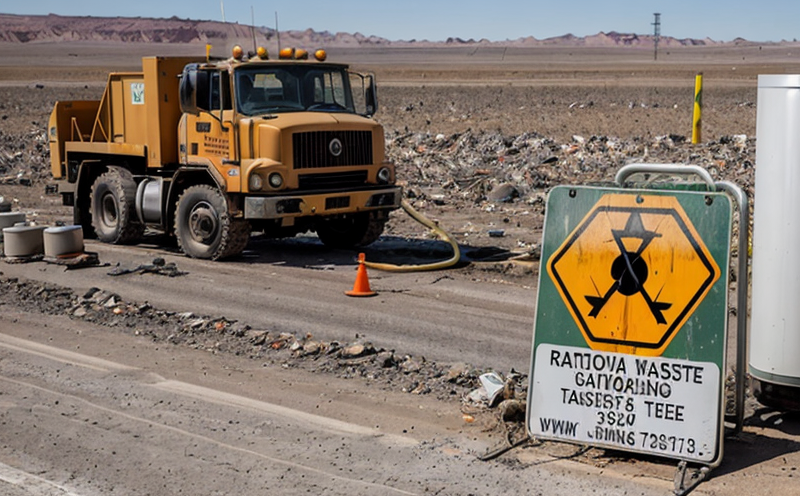ASTM C1128 Iodine-129 Determination in Waste
The determination of iodine-129 (I-129) in radioactive waste is critical for understanding the behavior, transport, and potential risks associated with this radiological contaminant. ASTM C1128 provides a robust method to quantify I-129 concentrations using accelerator mass spectrometry (AMS), which offers unparalleled sensitivity and specificity for this radionuclide.
Iodine-129 is of particular importance in the nuclear fuel cycle, as it can accumulate in spent fuel reprocessing residuals. Its long half-life (15.7 million years) makes it a significant concern for long-term storage and disposal solutions. Accurate quantification ensures that regulatory compliance and safety standards are met.
ASTM C1128 is widely recognized for its precision, accuracy, and reproducibility, making it the preferred method in laboratories around the world. The test involves several steps: sample preparation, chemical extraction of I-129 from the waste matrix, and subsequent analysis via AMS. This method allows for the detection of even trace amounts of I-129, which is essential given its low natural abundance.
The instrumentation used in ASTM C1128 includes high-resolution mass spectrometers capable of distinguishing between isotopes of iodine with minimal interference from other elements present in the sample. The process also requires thorough sample preparation to ensure that all I-129 is extracted efficiently, which can be challenging due to its low solubility and potential for complexation.
Understanding the behavior of I-129 in various waste matrices is crucial for assessing the effectiveness of containment strategies. This test plays a vital role in ensuring that nuclear facilities meet international standards set by organizations like the International Atomic Energy Agency (IAEA) and the Nuclear Regulatory Commission (NRC).
| Sample Preparation | Chemical Extraction | Analytical Method |
|---|---|---|
| Grinding, sieving, homogenization | Aqueous extraction using selective reagents | Accelerator Mass Spectrometry (AMS) |
The precision and accuracy of ASTM C1128 have been validated through numerous studies and are consistently met across different laboratories. This ensures that the results obtained are reliable and can be used for decision-making processes related to waste management.
ASTM C1128 is particularly useful in R&D environments where new containment technologies or waste treatment methods are being evaluated. By providing precise I-129 concentrations, this test aids in optimizing these technologies and improving overall safety measures.
Industry Applications
The ASTM C1128 determination of iodine-129 is widely applied across various sectors, including nuclear fuel reprocessing, spent fuel management, and radioactive waste characterization. This test ensures that regulatory requirements are met and that the potential risks associated with I-129 are adequately managed.
| Application | Description |
|---|---|
| Nuclear Fuel Reprocessing | Detection of I-129 to assess contamination levels and optimize reprocessing processes. |
| Spent Fuel Management | Quantification of I-129 in fuel residues for safe disposal strategies. |
| Radioactive Waste Characterization | Absence or presence of I-129 to classify waste and determine appropriate storage solutions. |
In nuclear fuel reprocessing, the accurate determination of I-129 is essential for minimizing contamination in the final products. This helps in maintaining the integrity of the fuel cycle and reducing environmental hazards. In spent fuel management, ASTM C1128 aids in identifying residual amounts of I-129 that could affect waste form stability and leachability.
For radioactive waste characterization, this test is crucial for proper classification and disposal planning. The presence or absence of I-129 can influence the choice of containment materials and the selection of final repositories. By ensuring accurate quantification, ASTM C1128 supports compliance with international standards such as those set by the IAEA.
Why Choose This Test
- Precision: Provides highly accurate results for trace amounts of iodine-129.
- Sensitivity: Detects even minute quantities, crucial for compliance and safety.
- Specificity: Differentiates I-129 from other isotopes of iodine with high selectivity.
- Regulatory Compliance: Ensures adherence to international standards like ASTM C1128.
- Reproducibility: Consistent results across different laboratories, enhancing trustworthiness.
- Supports R&D: Essential for evaluating new containment and treatment technologies.
The ability of ASTM C1128 to provide precise and reliable data is paramount in the nuclear industry. It supports critical decision-making processes related to waste management, fuel reprocessing, and regulatory compliance.
International Acceptance and Recognition
The ASTM C1128 method for iodine-129 determination is internationally recognized for its reliability and accuracy. It has been adopted by numerous countries as a standard practice in nuclear waste management, fuel reprocessing, and radioactive material characterization.
Organizations such as the IAEA and NRC recommend this test due to its stringent quality control measures and consistent results. Laboratories around the world use ASTM C1128 to ensure that their findings are comparable and internationally acceptable.
| Standard Organization | Affirmation of Method |
|---|---|
| International Atomic Energy Agency (IAEA) | Recommended for global nuclear waste management. |
| Nuclear Regulatory Commission (NRC) | Approved for spent fuel and radioactive waste characterization. |
The widespread adoption of ASTM C1128 underscores its importance in the field. Its acceptance by regulatory bodies ensures that the results obtained are valid and can be trusted internationally.





